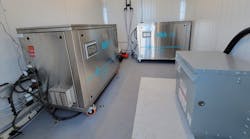EPA amends Risk Management Program for chemical facilities
The U.S. Environmental Protection Agency (EPA) finalized a rule amending its Risk Management Program (RMP) regulations to reduce the likelihood of accidental releases at chemical facilities and improve emergency response activities when those releases occur. T800; assist local emergency authorities in planning for, and responding to, accidents; and improve public awareness of chemical hazards at regulated sources.
The Accidental Release Prevention regulations – also known as the EPA RMP regulations – require covered chemical facilities to develop and implement a risk management program, which will be shared with state and local officials to help them plan for and prevent chemical accidents and releases.
While numerous chemical plans are operated safely, in the last decade more than 1,500 accidents were reported by RMP facilities. These accidents are responsible for causing nearly 60 deaths; some 17,000 people being injured or seeking medical treatment; almost 500,000 people being evacuated or sheltered-in-place; and more than $2 billion in property damages.
EPA adds subsurface intrusion to the Superfund Hazard Ranking System
EPA finalized a proposal to expand the hazards that qualify sites for the Superfund National Priorities List (NPL). EPA assesses sites using the Hazard Ranking System (HRS), which quantifies negative impacts to air, groundwater, surface water and soil. Sites receiving HRS scores above a specific threshold can be proposed for placement on the NPL.
Subsurface intrusion is the migration of hazardous substances, pollutants or contaminants from contaminated groundwater or soil into an overlying building. Subsurface intrusion can result in people being exposed to harmful levels of hazardous substances, which can raise the lifetime risk of cancer or chronic disease. EPA targets sites on the NPL for further investigation and possible remediation through the Superfund program. Only sites added to the NPL are eligible to receive federal funding for long-term cleanup leading to a permanent remedy.
EPA finds nutrient pollution is widespread in lakes
EPA released the results of a national assessment showing that nutrient pollution is widespread in the nation’s lakes, with 4 in 10 lakes suffering from too much nitrogen and phosphorus. Excess nutrients can cause algae blooms, lower oxygen levels, degraded habitat for fish and other life, and lower water quality for recreation. The National Lakes Assessment also found an algal toxin – microcystin – in 39 percent of lakes but below levels of concern. Low concentrations of the herbicide atrazine were found in 30 percent of lakes.
The assessment is part of a series of National Aquatic Resource Surveys designed to provide information about the condition of water resources in the U.S. The surveys are conducted in partnership with states and tribes to provide national-scale assessments of the nation’s waters.
Lake managers can use the new interactive dashboard to evaluate site-specific information and to explore population-level results. Conducted on a five-year basis, future lake surveys will help water resource managers assess broad-scale differences in the data and perform trends analysis.
Global Water Intelligence opens nominations for 2017 Global Water Awards
Global Water Intelligence (GWI) opened nominations for the 2017 Global Water Awards. The annual awards are the most coveted in the water industry, recognizing excellence rewarding those initiatives in the water, wastewater and desalination sectors that are moving the industry forward through improved operating performance, innovative technology adoption and sustainable financial models.
Each year, the Global Water Awards are presented at the Global Water Summit, widely known as the leading water industry conference.
In line with the theme of this year’s Global Water Summit, Intelligent Synergies, several new awards categories have been announced for 2017 which seek to reward those initiatives bringing the digital revolution to water.
Global Water Intelligence invites all companies working in the industry to put forward nominations before January 31, 2017. Winners will be announced and awards presented at the Global Water Awards Gala Dinner at the Palacio de Cibeles, Madrid, Spain on April 24, 2017.
For information on nominations criteria and rules, and a full timeline of the awards process, visit www.globalwaterawards.com/how-to-nominate.


